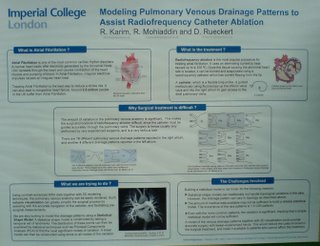It was a short meeting that we had today. We talked about how important it was for me to get the visualization done as quickly as possible. From there on we are planning to segment the images somehow first using some fundamental segmenting algorithms like Region growing. At some point we intend to be able to automatically get data for creating a Statistical shape model for the pulmonary drainage veins.
I also discussed my meeting with Dr. Tim Cootes at Oxford. After showing him the different drainage patterns, Cootes suggested that it would probably be a good idea to use more than just one shape model to describe a single pattern. However, I also explained to him how difficult it was to acquire images for patterns which are rare.
After discussing the rarity of the patterns, Prof. Daniel suggested that it would probably be a good idea if we could create models for the rare patterns with whatever data we have, and then declare that the model has some limitations. He also said that we could find out what proportion (e.g. 95%) of the data it explains (not clear on this)
